
Finland - diesel locomotives
For a full scale picture, please click on the picture shown !
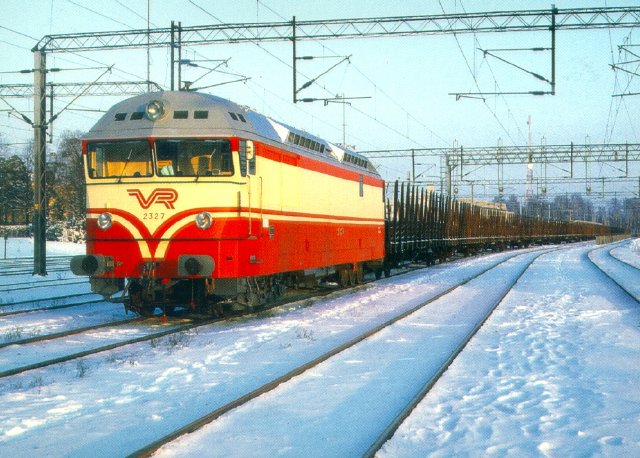
A Dr13 series unit 2327
Built by Lokomo in 1964 under license from the French company Alsthom.
Photo by Antti Roivainen.
Uploaded Feb 16, 1998
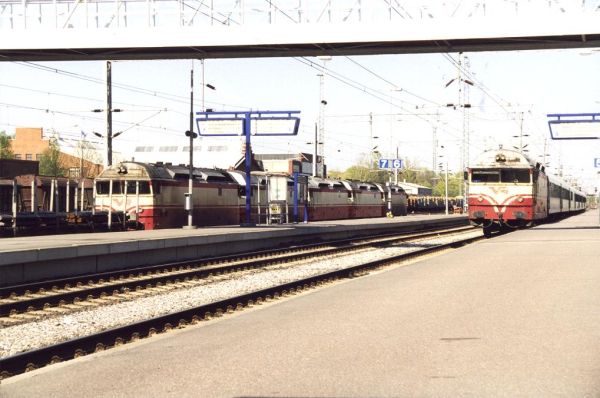
Six Dr 13 locomotives in one picture! To the left there are five Dr 13 locomotives in
one cargo train, and they have to wait for incoming express train P 110 (right),
which is arriving to Turku. P 110 is also being pulled by one Dr 13 (2337)
locomotive.
Photo taken in Turku, Finland, main railway station 16th of
May 1998. Photo by Lassi Luukkanen.
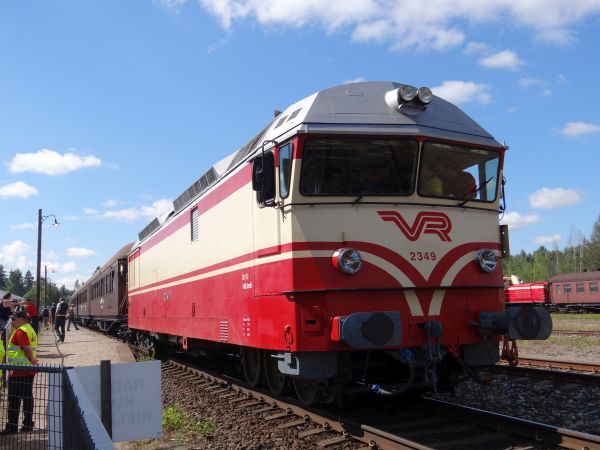
Class Dr13 heavy diesels were built by Alsthom in France and later also by Lokomo in Finland by a license from Alsthom in the beginning
of the 1960s. In the early stages of their life they had a very
bad reputation due to numerous design failures, but nevertheless they remained in service quite long. Nowadays one unit is preserved and
kept at the Finnish railway museum at Hyvinkää. It is also used in VR's museum train called Valtteri, just like here. This picture is from
the railway museum at Hyvinkää with the museum's Dr13 hauling a rack of wooden coaches from the 1930s and forming the museum heritage
train "Valtteri".
Photo from Hyvinkää railway museum 9.8.2015 by Ilkka Siissalo.
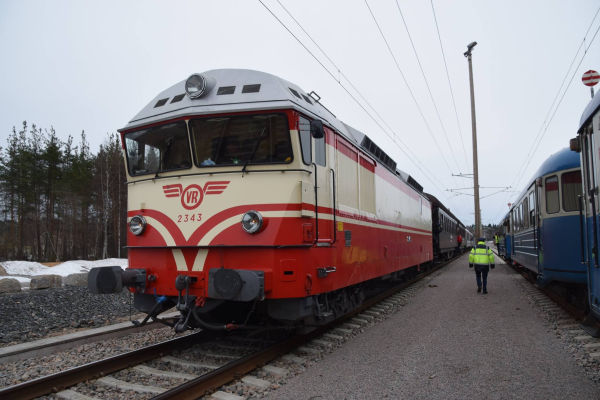
A rare sight in 2018: Class Dr13 locomotive 2343 owned by the museum train association Haapamäen museorautatieyhdistys is here meeting
an equally old train of blue and grey class Dm7 railbuses owned by the Keitele museum.
Picture from Suolahti 20.4.2018 by Jarkko Pasanen.
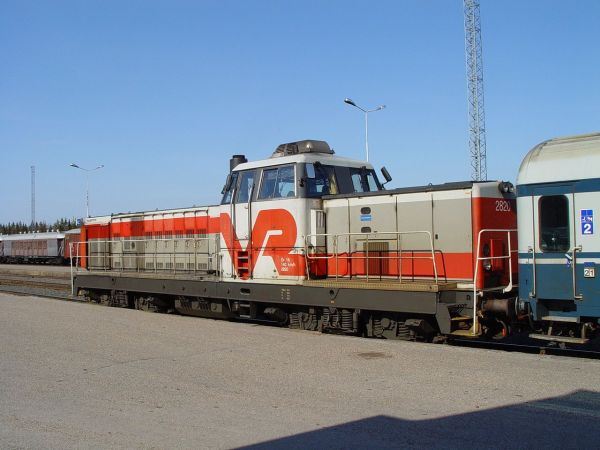
Even the newest diesel locomotives in Finland are already quite old. This is VR's newest
heavy duty diesel, class Dr16, nicknamed "iso vaalee" or "the big blonde".
Picture from Kontiomäki 20.4.2003 by Ilkka Siissalo
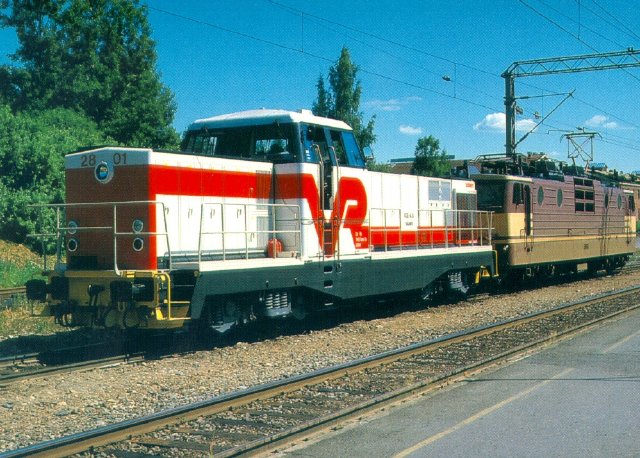
A class Dr16 series unit 2801 on test drive on 26 June 1986 with a class Sr1
series electric locomotive no.3091. This one is a prototype. If you compare the picture with the other pictures of Dr16
locomotives below, you can see several changes in e.g. lamps, undercarriage, air cooler on the roof etc.
Photo by Jarkko Voutilainen. Uploaded Feb 16, 1998.
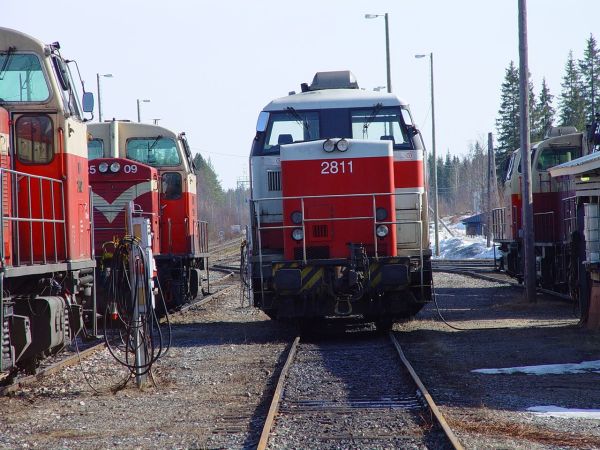
Another view of the "big blonde" class Dr16 seen from the front and surrounded by four class Dv12 diesels.
Picture 20.3.2003 from Kontiomäki by Ilkka Siissalo.
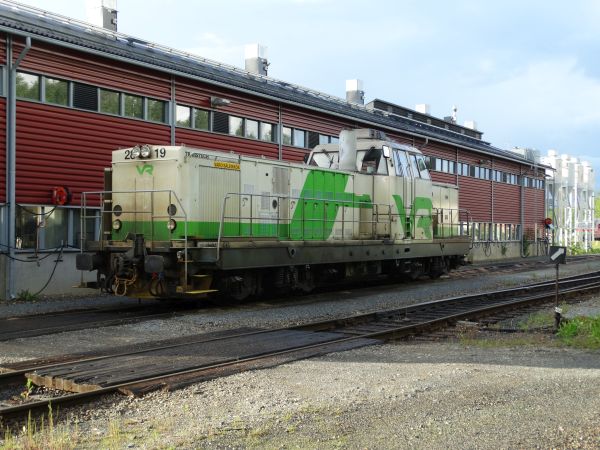
Most of the "Big Blonde" class Dr16 locomotives have already been painted in VR's new green and white livery.
Picture of one of the big blondes in Joensuu 26.6.2017 by Ilkka Siissalo.
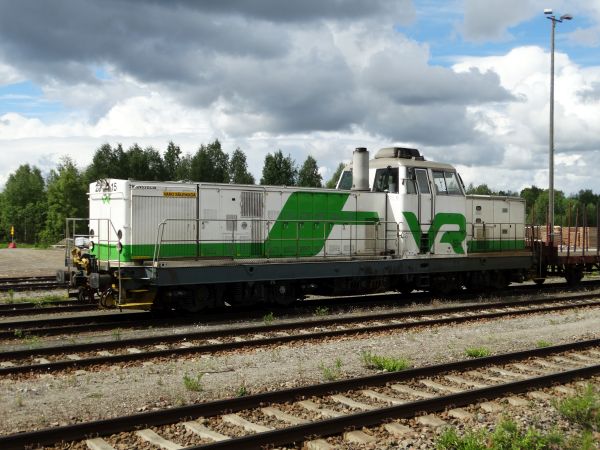
Another class Dr16 "big blonde" with a remarkably long cargo train waiting for another passing train at Lieksa station 27.6.2017.
Picture by Ilkka Siissalo.
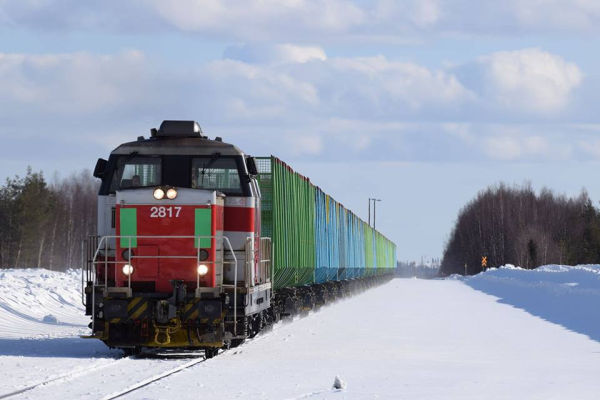
A class Dr16 locomotive no.2817 at Sieppijärvi, leading cargo train no. T5137 on 7.4.2018.
Picture by Aleksi Ylikangas.
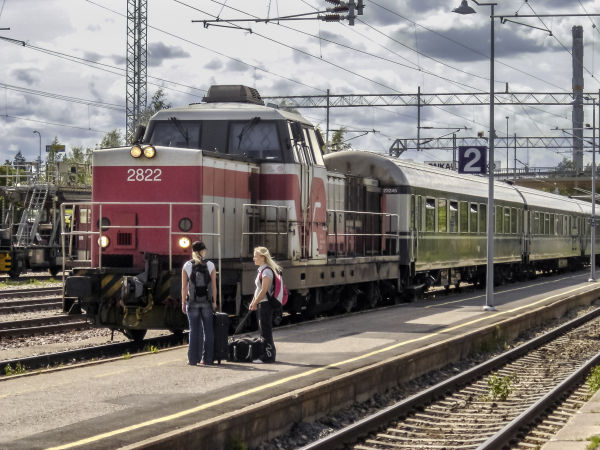
A very typical Finnish express train of those days, this is the train P971 in Kajaani 13.7.2006. The locomotive is
Dr16 no. 2822.
Picture by Mikko Nyman, edited by Pertti Heikkinen.
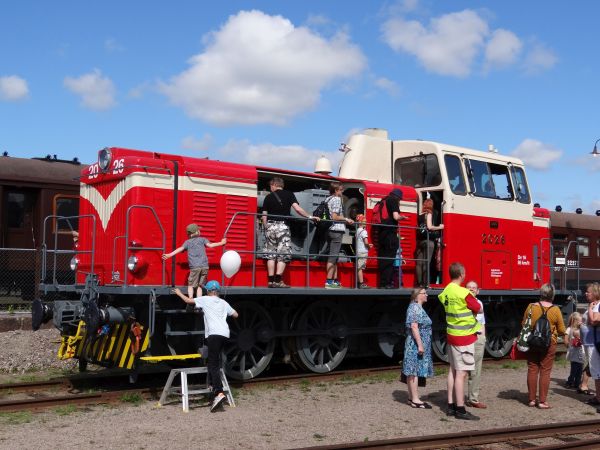
Railway museum visitors are getting a chance to look inside a beautifully restored old diesel of the class Dv16.
The last Dv16s were scrapped in 2008. It was a medium heavy diesel intended mainly for shunting, but was used also
in main and side line traffic, sometimes as a double pack. They were built by Valmet and Lokomo 1962-63. Top speed was 85 km/h.
Dv16 is almost identical to class Dv15, but a bit more powerful due to an added turbo intercooler and due to larger wheels.
Photo from Finnish railway museum in Hyvinkää 9.8.20015 by Ilkka Siissalo.
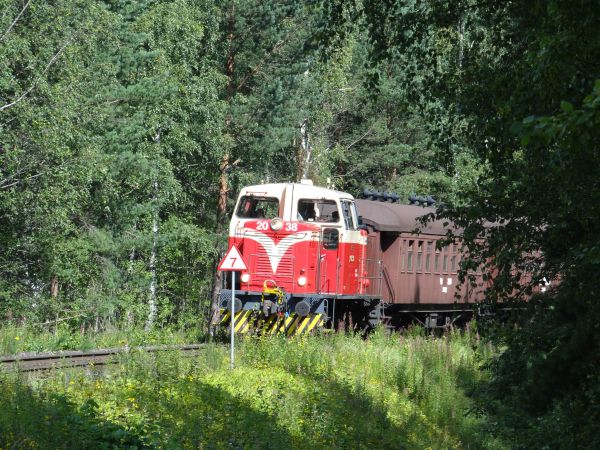
Dv16 number 2038 in full speed on the line hauling a rack of 1930s style wooden coaches forming a museum train from the railway
museum in Hyvinkää to Lohja and back on 9.8.2015.
Photo by Ilkka Siissalo.
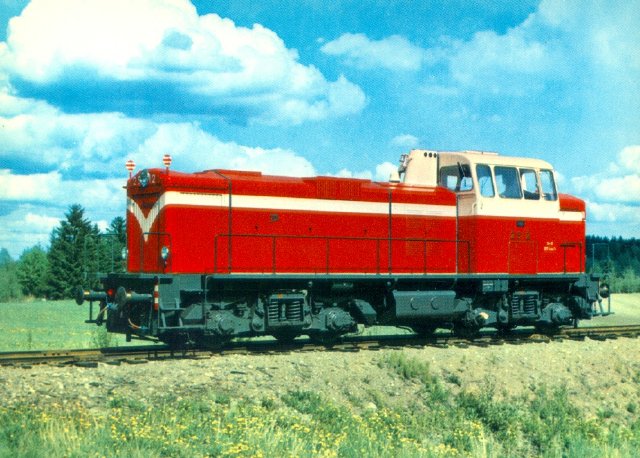
Dv12 series unit 2512
Built by Valmet in 1964.
Photo by Valmet Oy. Copyright Valmet. Uploaded Feb 16, 1998.
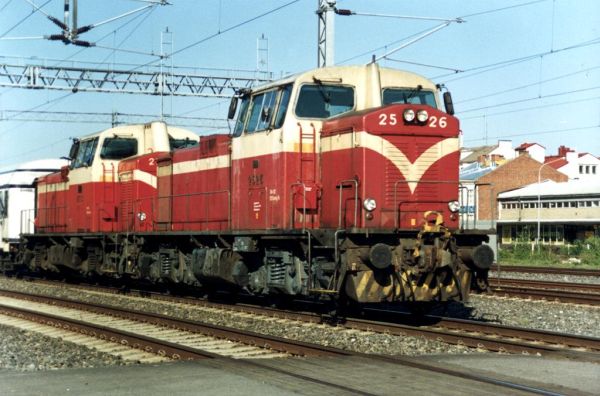
Express train P 112 is arriving to Turku. Just behind two Dv 12 locomotives
is the ferry company Silja Line's own coach, reserved for ship passengers. Photo taken in
Turku, north side of main railway station 16th of May 1998.
Photo by Lassi Luukkanen. Uploaded Jun 16, 1998.
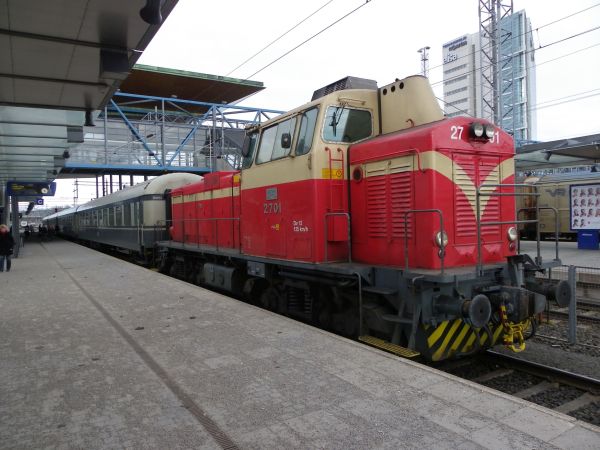
Class Dv12 is still nowadays the most common main line diesel in Finland, here still seen in the older red and yellow livery and with
1960s style blue and grey coaches. These blue coaches have almost all disappeared by now and also the Dv12s are gradually being painted
in VR's new white and green livery.
Photo from Jyväskylä station 13.4.2011 by Ilkka Siissalo.
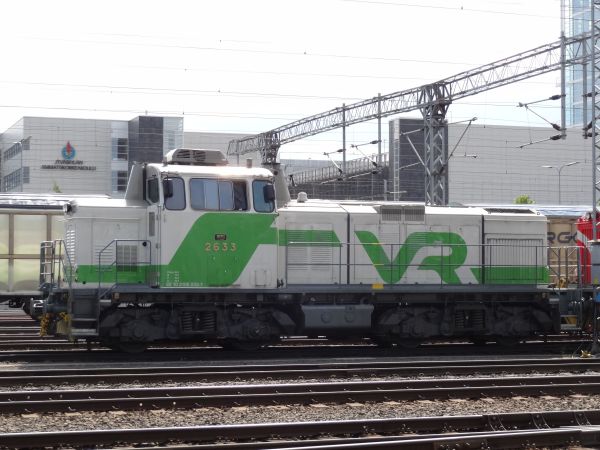
Most of the Dv12 locomotives have nowadays already been painted to VR's new green and white colours. For this individual type the new
painting does not even look particularly good.
Photo from Jyväskylä station 9.6.2012 by Ilkka Siissalo.
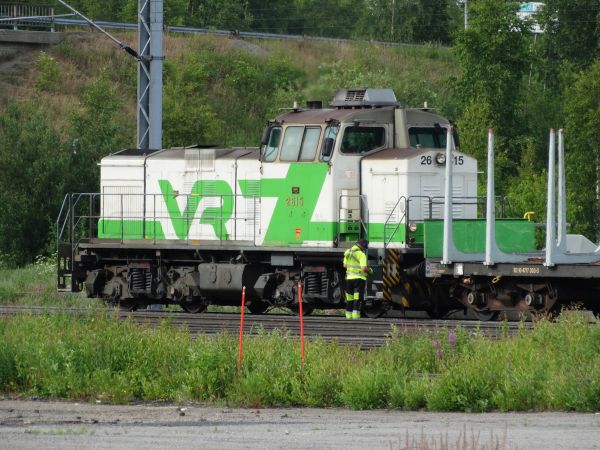
One of the Dv12s already painted in white and green doing shunting work at Kemi station.
Picture 11.7.2017 by Ilkka Siissalo.
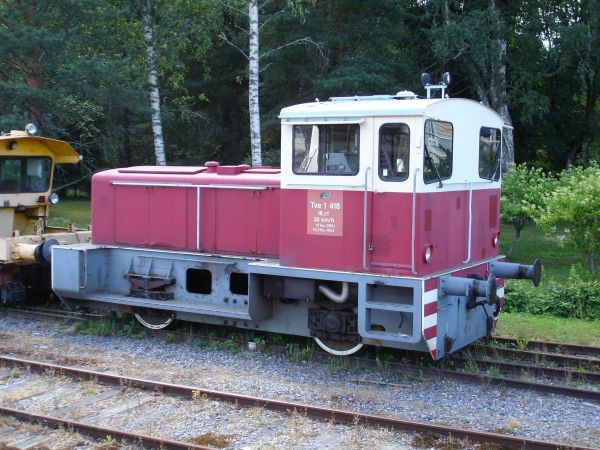
This is an old class Tve1 rail tractor, also known by the manufacturer Saalasti Oy's name Otso1. These were produced 1958-63
at the Turenki sugar factory by Saalasti Oy, now Teräspyörä Oy. Now this is historic museum equipment.
Photo from Porvoo station 29.7.2006 by Ilkka Siissalo.
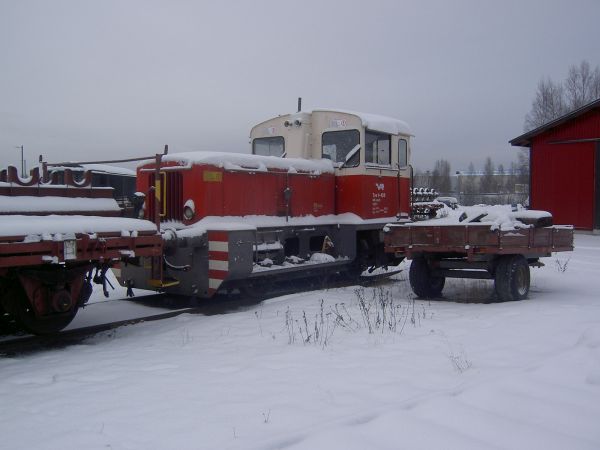
Class Tve1 rail tractor no.426 in Joensuu 11.12.2005.
Picture by Jimi Alppimaa.
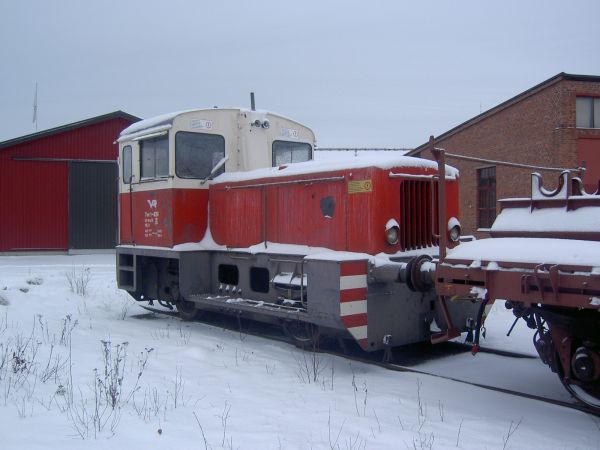
Another view of the class Tve1 rail tractor no.426 in Joensuu 11.12.2005.
Picture by Jimi Alppimaa.
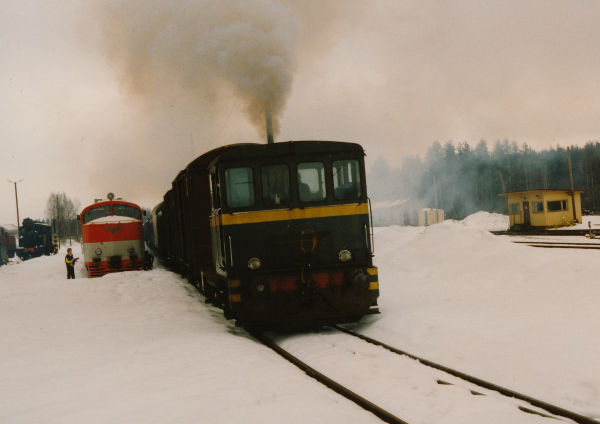
A class Vv13 light shunter is performing shunter duties at Haapamäki station. In the background, on the far left a steam shunter
of the class Vr1 "Kana" (Hen). Next to this train an orange and grey diesel multiple unit of either the type Dm8 or Dm9 can bee seen.
Nicknamed "Porkkana" (carrot), they were once common on all Finland's main lines. The type Vv13 is here seen still in its original
dark green livery. They were built by the company Valmet as Valmet's type Move 51. They are from the late 1950s. After a thorough
rehaul they were reclassified as class Tve in the beginning of the 1970s and even later as Tve3.
Picture from Haapamäki 4.4.1992 by Mikko Nyman.
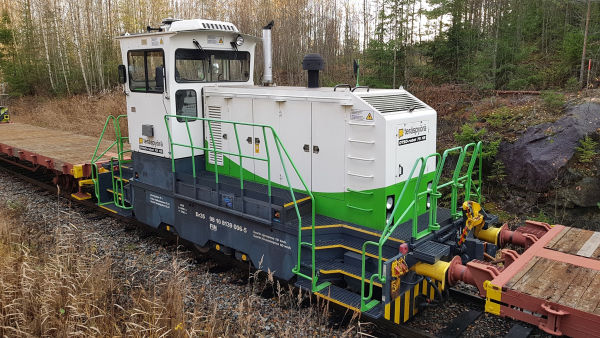
This fairly exotic looking light shunter locomotive is of the Finnish class Dr35. They were built by the company Teräspyörä (Steelwheel) as their type
Otso robot 75 HS. The type was designed for the use of Finnish state railways VR and that's why this machine is still in the green and white corporate
colours of VR Transpoint. VR tested two of these machines extensively at several depots since 2012, but was finally not completely happy with the design.
So far only two prototype locomotives have been built. The maximum speed of these locomotives is a modest 30 km/h. They are purely intended for switching duties only.
Picture from Kommila in Varkaus 24.10.2019 by Kusti Kinnunen.
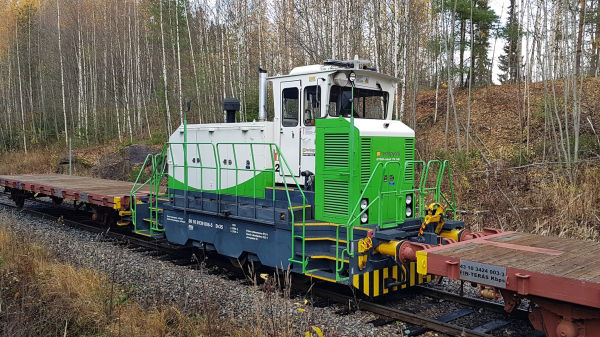
The same Otso robot 75 HS as above, but seen from the other direction.
Picture from Kommila in Varkaus 24.10.2019 by Kusti Kinnunen.
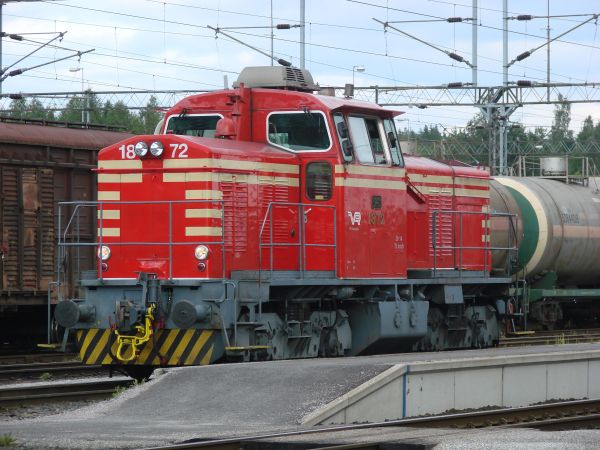
Class Dr14 is a heavyweight shunter machine, which only can be found on the busiest shunting yards in Finland. It is nicknamed "Seepra"
(Zebra) because of its typical stripy apparance as it was painted in its original red and yellow livery.
Picture from Vainikkala station by the Russian border 28.7.2006 by Ilkka Siissalo.
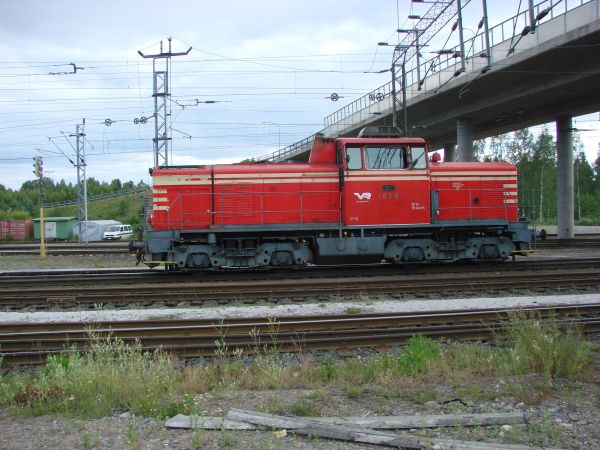
The same class Dr14 shunter as above, seen from aside.
Picture from Vainikkala station 28.7.2006 by Ilkka Siissalo.
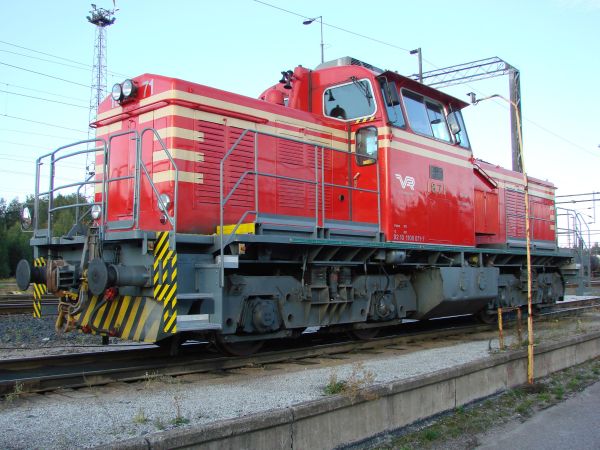
Another view of the class Dr14.
Picture from Vainikkala station 27.8.2009 by Ilkka Siissalo.
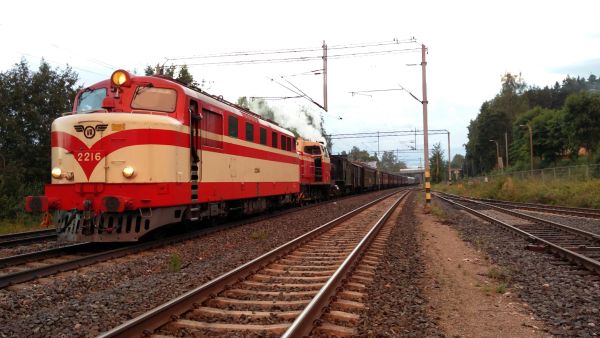
In the 1950s many European countries got new diesel locomotives based on 1930s US designs. In the Nordic countries, especially
Denmark, the Swedish company Nohab sold huge diesels based on a General Motors Corporation 1930s model. Finland would have wanted
these Nohabs also, but due to the lack of foreign currency, VR never got a license to buy locomotives from abroad. The result
was this model Dr12, commonly known as "Huru". It fairly closely resembles the US style GM diesels, although is not exactly similar.
These Hurus were the typical long distance express train locomotives of the 1960s and 1970s in Finland. 42 of these locomotives
were built 1959-63. Only two are left and only one of them - this one - is in working condition. The locomotive is owned by the
museum railway association Haapamäen museorautatieyhdistys. Behind the Dr12 Huru there is a class Dv16 diesel and a class Tk3
steam engine before a long rake of historic wooden coaches.
Picture from Turenki 5.8.2016 by Miko Rautiainen.
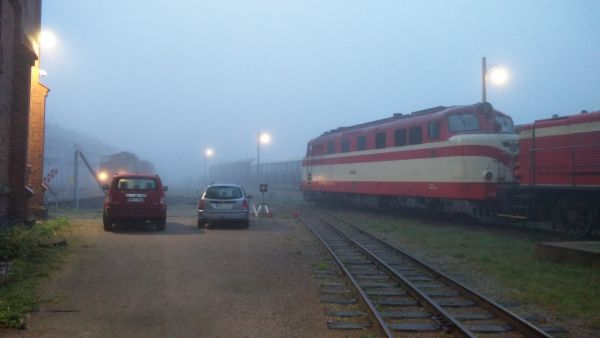
Another view of the class Dr12 Huru at Hyvinkää railway museum.
Picture at early morning of 6.8.2016 by Miko Rautiainen.
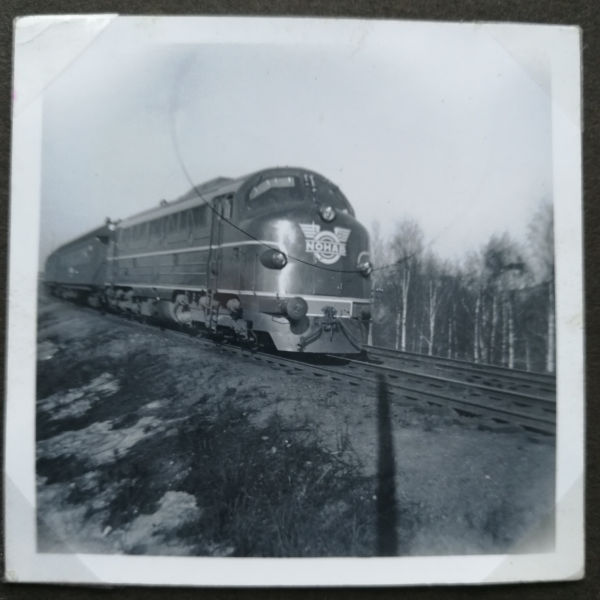
As already mentioned above, VR of Finland would actually have wanted to buy General Motors - Nohab diesels made in Sweden,
but finally never got the permission from Finland's bank to use so much foreign currency. As a substiture the model Hr12/Dr12
Huru was developed. But there was one GM-Nohab in Finland for test purposes, rented from the manufacturer Nohab. There are
relatively few photos of this "Finnish Nohab" published, but here is one. This is the rented Nohab with a rake of old
wooden VR coaches somewhere close to Helsinki. This locomotive was in use in Finland 1958-59 and it ran in Finland for about
257 000 km before it was returned to Nohab in Sweden. There is some snow in the picture, so apparently the picture is from
spring 1959. The picture is taken by Olli Nieminen and is published here with his permission.
Later Nohab sold this same locomotive to Norwegian state railways NSB where it served as NSB class Di3b no.643 until the
year 2000 when NSB sold it to the United Nations against a nominal price. UN took it to Kosovo and it was used there for
a long time. A picture of this exactly same locomotive in Polje, Kosovo in the year 2004 by Markku Salo can be found here:
http://railpics.club/Kosovo/ks-di3_643-kosovo-markku_salo-full.jpg
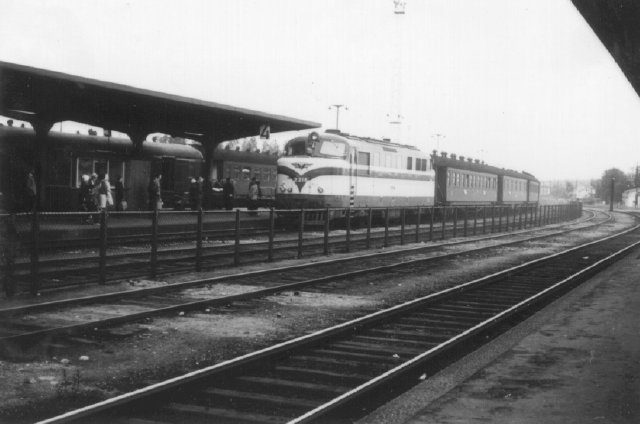
Passenger train at Riihimäki station in 1962, pulled by diesel
locomotive Hr12 (later class Dr12) no.2216.
Photo by Taisto Ketolainen.
Uploaded Feb 16, 1998.
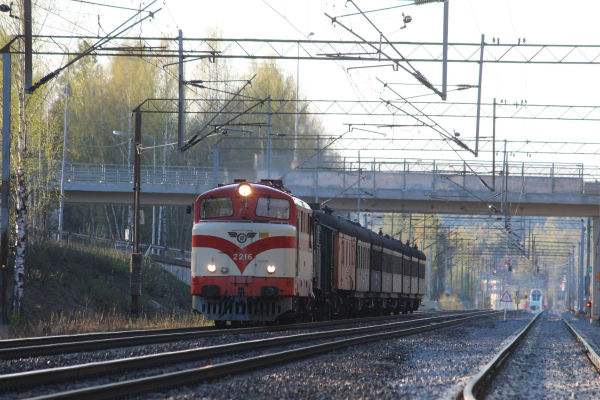
This picture could have been taken anytime in the late 1950s or early 1960s (if it weren't for the modern train just barely visible far away in
the background). But this is from May 2018 and it is a museal train owned by Haapamäen Museoveturiyhdistys HMVY (museum locomotive association
of Haapamäki). Their stylish old express train was visiting southern Finland.
Picture by Petja Touru in Hämeenlinna 8.5.2018.

